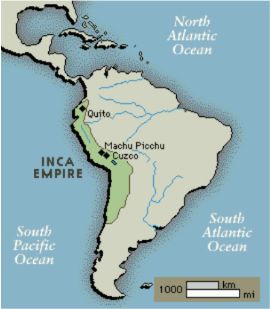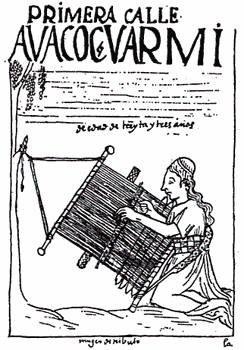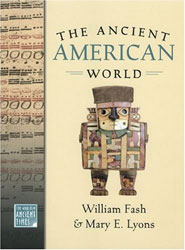|
 FIND AND SAY
FIND AND SAY
- Ancient American World takes you on a tour of ancient
civilizations in Mesoamerica. What the heck is Mesoamerica? It's an area
south of the United States. It includes parts of modern Mexico and at
least four countries in Central America. To prepare for the tour, do the
following:
- Some sites on the map below are written in Nahuatl (nah WHAT). One
million people in Mexico still speak this ancient language. Point to the
following cities on the map and say their names three times. (No
cheating-three times!)
Oaxaca - wah HAH kuh
Teotihuacan - Tay oh tee HWAH kahn
Tenochtitlan - Tee noch TEET lahn
- Other sites are written in the Spanish language. Point to these cities and
. . . well, you know what to do. Three times.
Copán - co PAHN
Chichén Itzá - chih CHEHN eet ZAH (or chicken pizza if you're feeling witty)
Monte Albán - MOHN te ahl BAHN

map courtesty of
http://www.mesoweb.com
 STIR AND SIP STIR AND SIP
- Aztec emperors controlled most of Mesoamerica from the 14th century CE
(1300's) until the 16th century CE (1500's). If you think people in the Aztec
empire invented chocolate, think again. Mesoamericans who lived thousands of
years earlier figured out how to grow cacao plants and process the beans. The
result: chocolate.
- Ancient Mesoamericans made a frothy chocolate drink with cocoa, cold
water, and spices. To taste a modern version of their treat, try the
following:
- Visit a large grocery store or a Mexican food market. Buy a small jar of
ancho chile powder and a box of powdered achiote root, or annatto.
- Make your usual cup of hot chocolate with milk.
- Add a dash of ancho chile powder for a spicy taste.
- For color and deeper flavor, add a pinch of annatto.
 FIND AND SAY FIND AND SAY
- Spaniards invaded Mesoamerica in 1519 CE. By 1521, they controlled the
entire Aztec empire. Eleven years later, they conquered the Inca empire in
South America. Ancient American World takes you on a tour of the Inca empire
and all the civilizations that came before it. To prepare for the tour, do the
following:
- Three Inca cities are shown on the map below. Machu Picchu is a Quechua (kuh
CHEW ah) word. At least eight million people in South America still speak this
ancient Inca language. Point to Machu Picchu and pronounce it three times.
Machu Picchu - MAH chew PEEK shu
- The city of Quito is near the northern boundary of the old Inca empire.
To the south is Cuzco, the capital city of the empire. Both have Spanish
pronunciations. Point to them on the map and say them three times.
Quito - KEET oh
Cuzco - KOOZ koh

Map courtesy of http://www.peru-explorer.com
 MAKE A POSTER MAKE A POSTER
(This activity requires computer skills. Don't be shy. Ask for help if you
need it.)
- Open a blank document in the word processing program on your computer.
- Guamán Poma was a native Peruvian. He drew the picture below sometime
during the 16th century (1500's). Copy and paste the picture into the
blank document.
- Print the page. Add color to the drawing if you like. Be sure to give
credit to the artist. Write the words "Illustration by Guamán Poma" under
the picture.

- Visit http://www.wordcentral.com
Look up this list of words:
woof
shuttle
warp
loom
weft
- With your very best cursive (yes, cursive-we should all practice this
skill) handwriting, copy the following paragraph below the picture. Use
the word list to fill in the blanks.
This Inca woman is weaving with a backstrap _____ . She has tied long
pieces of of yarn to two sticks. These longer pieces of yarn are the
______ . With a stick called a ______, she passes shorter lengths of yarn
called the weft, or ______ , over and under the warp.
 DISCOVER DISCOVER
- Weaving is the oldest craft in ancient America. By the
time the Inca empire began in 1438 CE, it was already 4,000 years old. To
learn how ancient weavers wove without a loom, read "A Warped Idea" in
Ancient American World, p.114.
- For a cool photograph of 4000-year-old woven bags, see
p. 116 in Ancient American World.
|




